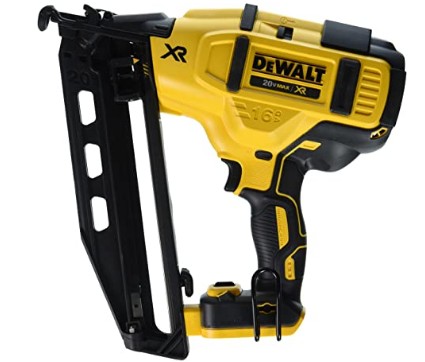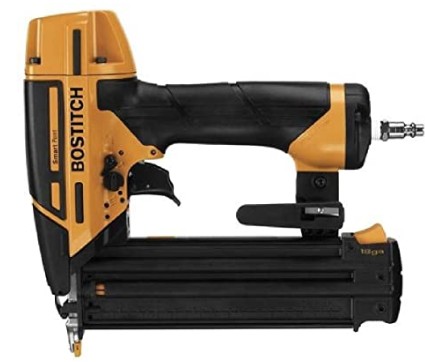How To Remove A Brad Nail From Wood
Whether y'all're a novice or expert, we all know that choosing the right fastener judge is essential for a clean woodwork project. However, woodworkers are often dissever over the appropriate estimate to apply when using a brad nailer. Choosing the right fastener size will determine the stability of the woodwork and finished look. So what do you choose between a 16 approximate and xviii gauge nailer?
The answer to this question depends on personal preference and the type of project y'all have. The most significant divergence between the 16-estimate and 18-judge brad nailer is that the sometime uses thicker nails than the latter. The all-time manner to decide what estimate to utilise is get-go to understand what each gauge is ideal for, what each gauge can and cannot practice. This article will provide you with the necessary information on the differences, similarities, and uses of a 16 gauge and eighteen approximate nailer.
What does gauge hateful?
The gauge of whatever smash gun generally refers to the dimensions of the nails. When it comes to a brad nailer, a gauge is the thickness of the nail and the diameter of the nail caput. The judge size is too the number of the judge is the number of nails or pins that fit in 1 inch when lines side by side. The general dominion is the lower the guess number, the thicker the nails. Therefore, nails that fit 16 into one inch of the nailer band are typically bigger than the eighteen nails per inch.
Pros of a 16-gauge nailer
- Information technology is most suitable for projects that require more than stability and property ability.
- Fantabulous for penetrating large baseboards and plywood and attaching large crown molding.
- It uses nails of ane-3½-inch in length.
Cons of a 16-approximate nailer
- Information technology is more probable to divide thinner wood and narrow boards.
- The bigger nails practise not give a bang-up or shine finish, therefore, requiring filling and sanding.
Pros of an 18-gauge nailer
- It is nearly suitable for finer and more than delicate wood projects.
- Information technology requires piddling to no filling with wood putty or sanding.
- It uses nails of ½-ii½-inch in length.
Cons of an 18-judge nailer
- It has less penetrating forcefulness compared to a 16-gauge nailer.
- It does non penetrate heavier and larger wood and moldings well like MDF.
- It does not reach corners and tight spots easily.
What is the difference between 16-approximate nailers and xviii-gauge brad nailers?
The choice of what nailer judge fits all-time depends on some factors, which we have explained below.
Size of projects or tasks
Due to its smaller size, the 18 gauge nailer is nigh suitable for small-scale and lite projects and attaching a thin board. Examples of some best-suited projects for an 18-approximate nailer are piece of furniture construction, picture frame assembly, cabinet installation, and finishing touches. The 18-guess brad nails are not strong plenty to hold a workpiece and requite it stability, only they provide a smoother and cleaner finish.
On the other hand, a 16-approximate nailer is cracking with heavier projects that utilize thicker wood boards that adhere directly to the wall and requite better back up. A 16-estimate nailer would is more suitable for tasks similar casing windows, bedding, dado rail, molding, trimming, and baseboards. Therefore it is best for projects that require more structural integrity and durability.
Nail size
The gauge number determines the size and thickness of the blast. The college the gauge number, the smaller the pin is. It means that the nails used on an 18 estimate nailer are slightly thinner than those on a 16-gauge nailer. The diameter of the 16-judge nail is 1/16 of an inch wide while the diameter of the 18-approximate nail is less than ii/64 of an inch. The boom diameter is essential as it affects crown molding and how it attaches to the trim.
For instance, yous have to employ bigger nail sizes for thicker boards to avoid bending the nail, while thinner boards require smaller-sized nails. Both 16-gauge and 18-gauge nails can go through calorie-free boards without leaving visible marks, but the 16-gauge nails are more than likely to cause bang-up since it is slightly thicker.
Type of woods
The type of woods you lot want to use for your projects may likewise bear on the size of the nailer to use. Soft and smaller types of timber will require the eighteen-gauge nailer, while thicker types of food like fencing require the 16-gauge nailer. Using the 18-nailer gauge on thicker forest volition bend from the force per unit area of the nails.
Versatility
Professional person woodworkers consider the sixteen-gauge nailer more versatile as it works with whatsoever heavy woodwork due to its strong holding power. These nailers are also bachelor in pneumatic and cordless configurations. On the other hand, xviii-gauge nailers create weak attachments that are very easy to split past hand.
Stop
For clean and neat finishes, the eighteen-gauge nailer is what you should go for because of the thinner nails. Nonetheless, the 16-gauge nailer is more than probable to get out dents on the forest surface, and you may have to utilise some woods putty for a smoother finish.
Attachment forcefulness
Both nailers are nifty for attaching boards, only the force exerted is unlike. The 16-estimate nailer has a greater attachment force making it great for heavier tasks. The xviii-gauge nailer has a smaller zipper forcefulness.
Check this also: What Is a Pin Nailer Used For
What are brad nailers adept for?
Brad nailers are specialized nail guns for detailed woodwork and take typically replaced hammers. Brad nailers are great for applying trimming and molding or applying finishing touches to a woodwork project since they employ very thin pin-similar nails. In addition, brad nailers are swell when you need to practice light woodwork effectually the firm as they bulldoze nails without splitting minor woods boards. Here are some other uses of a brad nailer.
Baseboards
Due to the small-sized nails, a brad nailer is bully for attaching baseboards to walls or larger wood pieces effortlessly. Baseboards are fragile. Therefore, they crave thinner nails and a nailer that uses the right amount of force without splitting or cracking the wood. Brad nailers also give the neatest finishing and do not leave marks or dents that crave finishing putty.
Crown molding
Crown molding is the pocket-sized baseboard covering the lining between the ceiling and the wall surface, which requires sparse nails for a smooth finish.
Crafts
A brad nailer is easy to employ, which makes information technology suitable for DIYers and woodwork beginners. Every bit a beginner, the brad nailer is user-friendly, and you can easily remove the nails without much damage to the wood equally it doesn't have much-belongings ability.
The best 16-estimate and xviii-approximate nailers
If yous're working on heavier projects, you lot should go for the 16-guess nailer but if you plan on trimming and molding, choose the 18-gauge nailer. Below nosotros have given a review of our meridian-picks brands of a 16-gauge and 18-gauge nailer to help you make it easier to choose between the two options.
1. DEWALT 16GA Finish Nailer

Dewalt is a very popular brand with great power tools, including a multifariousness of nail guns. This specific nailer uses 20-volt batteries, which eliminates the need for a compressor or gas tank. It also features multi-functional LED lights, which illuminate the workspace and tool diagnostics.
Features
- 16 gauge terminate nailer
- i inch to 2 ½ inch boom length
- 20-degree angle
- xx-volt batteries
Pros
- Information technology is durable with excellent construction quality.
- It is cordless, which allows for easy mobility.
- Convenient for both right-handed and left-handed users.
Cons
- It is heavy.
Check it on Amazon
Check this too: All-time Battery Powered Smash Gun
2. BOSTITCH 18GA Smash Gun, Brad Nailer

The Bostitch 18-gauge (BTFP12233) nailer is an air-powered brad nailer that uses eighteen-gauge brad nails of 5/8-inch to 2-one/8-inch in length. It has a Tool-complimentary jam release mechanism for easy nail removal and prevents jamming. In addition, this xviii-gauge brad nailer is oil-gratuitous, reducing the risk of oil stains and making the tool maintenance very low.
Features
- 18-gauge brad nailer
- 5/viii-inch to 2-1/8-inch smash length
- Air-powered
- 110 volts
- Selectable trigger system
Pros
- It is easy to use.
- It is lightweight and durable.
- It requires low maintenance.
Cons
- The straight magazine does non fit in tight spots.
- It does non point how many nails are in the mag.
Cheque it on Amazon
Wrapping it up
When deciding whether to go for a 16-gauge or eighteen-guess nailer, you lot should consider the weight and thickness of your woods piece. The sixteen-gauge nailer is smashing for thicker and harder wood, while an eighteen-gauge nailer is well-nigh suited for thinner woods and has a neater end. If your budget allows, especially if its a concern, yous should get both and so that you have the proper brad nailer for a diversity of moldings and trims
Source: https://nelsgarage.com/16-gauge-vs-18-gauge-brad-nailer-which-should-you-get/

0 Response to "How To Remove A Brad Nail From Wood"
Post a Comment